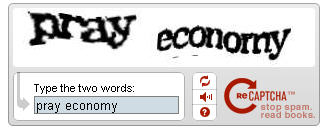No doubt you’ve had to type something in response to something like this when you wanted to cast an online vote, buy some tickets, sign up for a new account, or take care of some other task in your online life:
This is called a CAPTCHA and it is a challenge response system designed to cut down automated spam on the web. CAPTCHA is an acronym that stands for Completely Automated Public Turing test to tell Computers and Humans Apart. Many developers have come up with such systems since its original invention and naming back in 2000 by Luis von Ahn, Manuel Blum, Nicholas J. Hopper, and John Langford at Carnegie Mellon University. Yet, there is something very notable and unique about the “reCAPTCHA” brand of CAPTCHAs that piqued my interest.
In the case of reCAPTCHA, when a human types a solution into the box it is checked against a database of unsolved Optical Character Recognition (OCR) text from old books, magazines, and transcripts of old radio programs. As more people look at the text, which is not recognizable by computers with OCR software, and enter their response, those common responses are returned as correct responses to the system and onward you go! Each solved word then gets returned to a database to help figure out the missing text which was previously unrecognized by a computer.
Google acquired reCAPTCHA in 2009 in an effort to aid its book digitization and you can read more about the technology on Google’s reCAPTCHA page. There is a short video about the technology in the own words of one of its developers here.
It’s great when one technology can solve two problems, and that is the lesson that our young people can learn from the reCAPTCHA story. Think about some other technologies that came to popularity because they addressed two or more previously disconnected problems. This is the stuff that results from great knowledge, creativity, and ingenuity.


Leave a Reply
You must be logged in to post a comment.